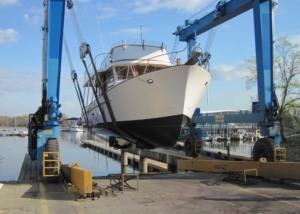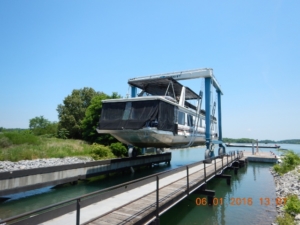A Marine Survey is a statement of opinion from a professional marine surveyor about the condition and value of a vessel based upon his detailed first-hand inspection. I survey according to Federal (USCG) and American Boat and Yacht Council (ABYC) standards and as a member of SAMS® all of my surveys must meet or exceed the SAMS® Recommended Survey Report content requirements.

Pre-Purchase Survey
The most comprehensive type of survey which is normally done prior to the purchase of a new or used boat. The surveyor should be engaged by the prospective buyer as it his interests that the surveyor will be working for. This survey should be an exhaustive inspection covering every detail affecting the boat’s condition and safety including a thorough evaluation of all onboard systems, structural integrity of all components, the extent of existing problems, suggestions for upgrades and needed repairs. The vessel is best inspected both in and out of the water and underway for a trial run. The Pre-Purchase Survey also provides an estimate of the vessel’s Fair Market Value (FMV) to make sure you don’t pay too much, along with an opinion of its condition and replacement cost. If you are purchasing a boat or yacht you should always insure that the purchase agreement and price are contingent upon a satisfactory Marine Survey.
Condition & Value Survey
This inspection may be required by insurance companies when a vessel is acquired and at periodic intervals thereafter to insure a safe risk for coverage. It may also be requested by financial institutions to determine value of a vessel for loan or estate valuation. Many aspects of the Pre-Purchase inspection are covered, but with greater emphasis on potentially hazardous flaws and safety issues. Precise identification of all valuable gear and an opinion of the vessel’s fair market value and insurability are always included. For older boats and new policies, insurance underwriters normally require a haul out inspection to inspect the vessels wetted area and underwater machinery.
Damage Survey
The purpose of a Marine Damage Survey is to assess the extent of the damage sustained by the hull, rig, systems or elsewhere on the vessel. The report presents information on the probable causes of the damage, recommendations on repairs, and validates repair estimates for such work. Surveyors are typically hired by insurance companies to investigate claims. Occasionally, a surveyor is hired by the boat owner directly to investigate out of the ordinary degradation or damage.
Walk-Through
– If you are considering the purchase of a vessel but are a substantial distance away, I can perform a ‘Brief Walk-through’ of a prospective boat to help you decide whether it is ‘worthy’ of investing in the cost of a full Marine Survey. After the walk-through, I will forward you photos and my initial opinion of the vessel.

Survey Limitations
Most Marine Surveys are non-destructive in nature. As a result, hidden flaws and latent defects which can not be discovered without dismantling the boat or disassembly of equipment are not assessed. Locked doors, hatches or panels that are screwed down will not be surveyed unless opened by the owner or his representative. It is in the owners or the buyers best interest (dependent upon the type of survey) to have these panels opened up prior to arrival of the surveyor to allow for proper inspection.
The same can be said regarding excess gear and equipment that blocks access or impedes visibility. Having to look over, under, around and even through mountains of personal effects or unnecessary equipment makes the surveyor’s job even more difficult if not impossible. All items that are not necessary for the safe operation of the vessel or will not be conveyed with the sale (if Pre-Purchase) should be removed from the vessel prior to the survey.
Survey of rigging on sailboats is performed from the deck level only. No attempt will be made to go aloft. Personal property or equipment should be removed to facilitate access for the survey.
In addition, the surveyor can only report on the boat’s condition as it existed at the time of survey. No warranty of condition or performance is provided.
If any removal, disassembly or destructive testing is to be performed, written authorization from the vessel’s owner must be procured in advance.
Recommended Survey Content
All surveys produced by Safe Passage Marine will adhere to the ‘Recommended Survey Report Content’ prescribed by SAMS®. Each report will contain the following information as a minimum. Damage surveys will be somewhat different as the survey focuses only on the area of damage as presented by the claimant. Thus many systems and other equipment may or may not be included within the survey.
| The scope of the survey is primarily set during the initial contact with the client. Will the vessel be hauled or will the survey be in the water only? Will there be a sea trial? Will shore power be available? Will shore water be available? LPG? A good survey will document in its “Scope of Survey” what was surveyed and what was not. The conditions, weather, location, availability of power, water, gas etc. will be listed as they impact the conduction of the survey. |
All vessel systems will be listed and described with regards to condition, operation and or deficiencies. Some common examples;
|
